Report on Mental Health and Wellbeing: A Whole Person Approach
VerifiedAdded on 2022/09/02
|14
|5321
|23
Report
AI Summary
This report, titled "MENTAL HEALTH AND WELLBEING: A WHOLE PERSON APPROACH," delves into various aspects of mental health. It begins with an introduction to mental illness and the role of community-based organizations in supporting individuals. Chapter 1 focuses on mental health awareness, assessing the need for positive mental health and the influence of psychological and social factors. Chapter 2 explores early intervention, discussing primary signs of mental distress, action plans, and the impact of childhood experiences. It also examines strategies for building mental health resilience. Chapter 3 aims to train the reader on promoting mental wellbeing. The report covers promoting wellbeing and mental health and provides an overview of stress management techniques. Chapter 4 focuses on first aid for mental health. The report concludes with a summary of key findings and a reference list.
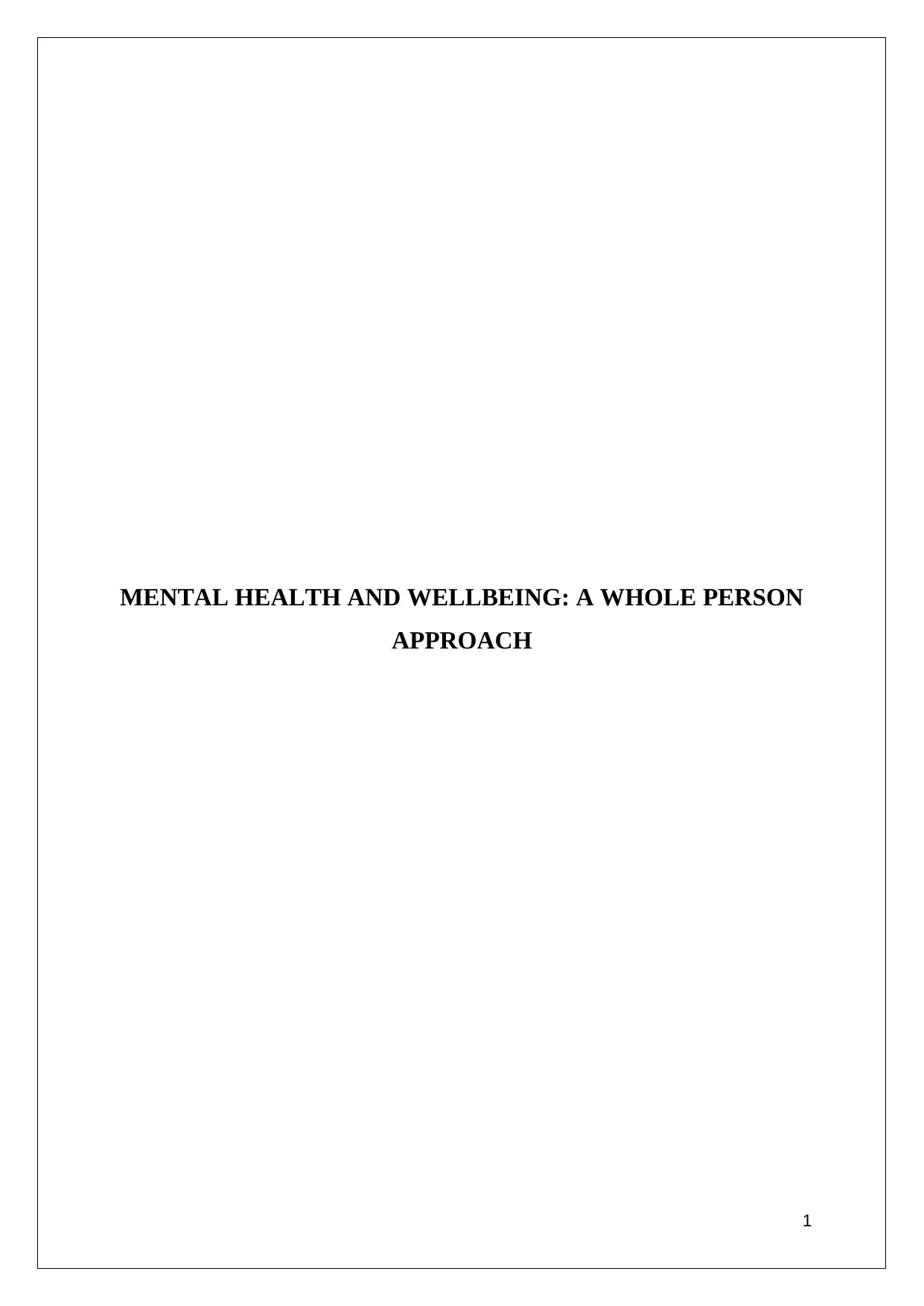
MENTAL HEALTH AND WELLBEING: A WHOLE PERSON
APPROACH
1
APPROACH
1
Paraphrase This Document
Need a fresh take? Get an instant paraphrase of this document with our AI Paraphraser
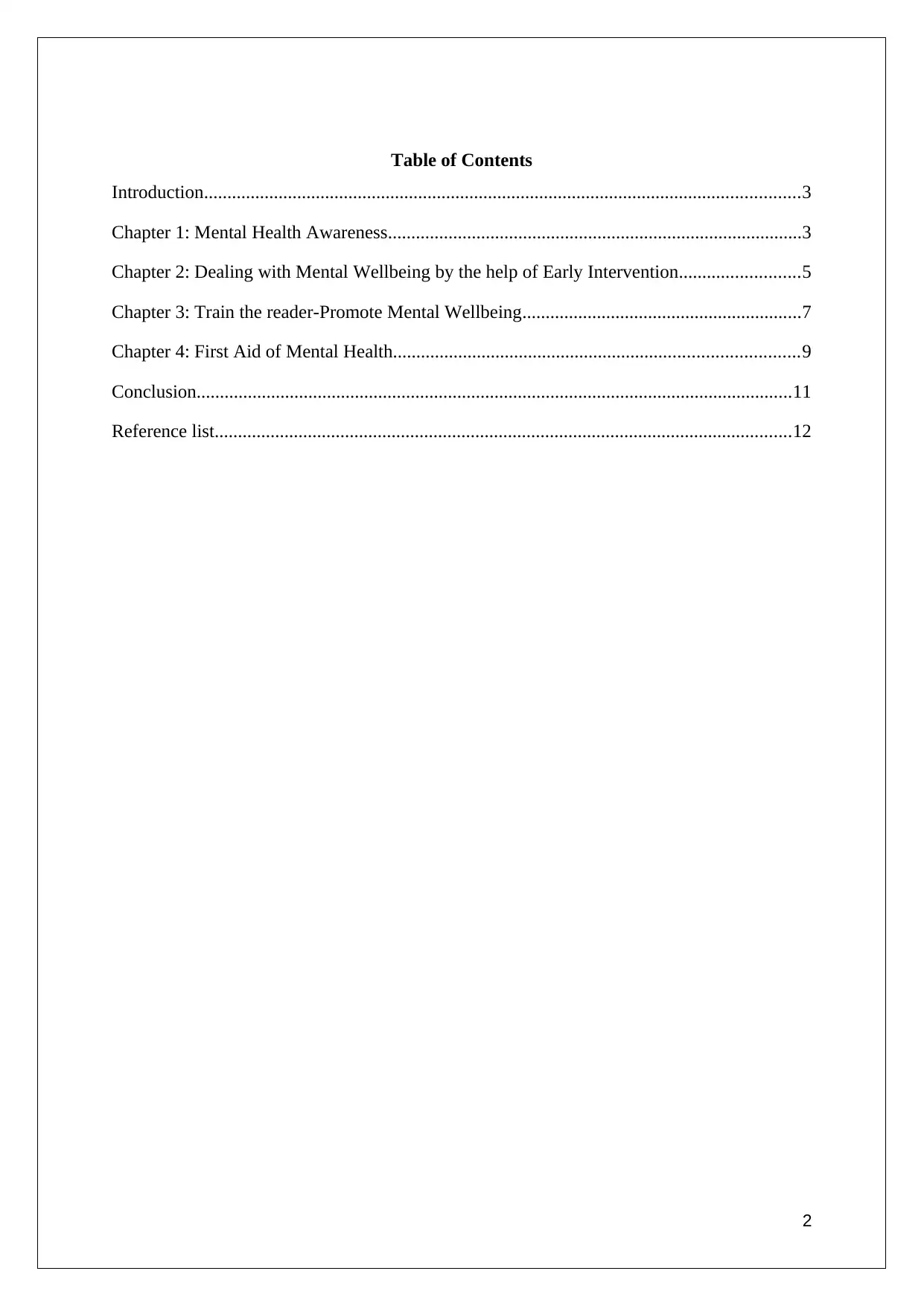
Table of Contents
Introduction................................................................................................................................3
Chapter 1: Mental Health Awareness.........................................................................................3
Chapter 2: Dealing with Mental Wellbeing by the help of Early Intervention..........................5
Chapter 3: Train the reader-Promote Mental Wellbeing............................................................7
Chapter 4: First Aid of Mental Health.......................................................................................9
Conclusion................................................................................................................................11
Reference list............................................................................................................................12
2
Introduction................................................................................................................................3
Chapter 1: Mental Health Awareness.........................................................................................3
Chapter 2: Dealing with Mental Wellbeing by the help of Early Intervention..........................5
Chapter 3: Train the reader-Promote Mental Wellbeing............................................................7
Chapter 4: First Aid of Mental Health.......................................................................................9
Conclusion................................................................................................................................11
Reference list............................................................................................................................12
2
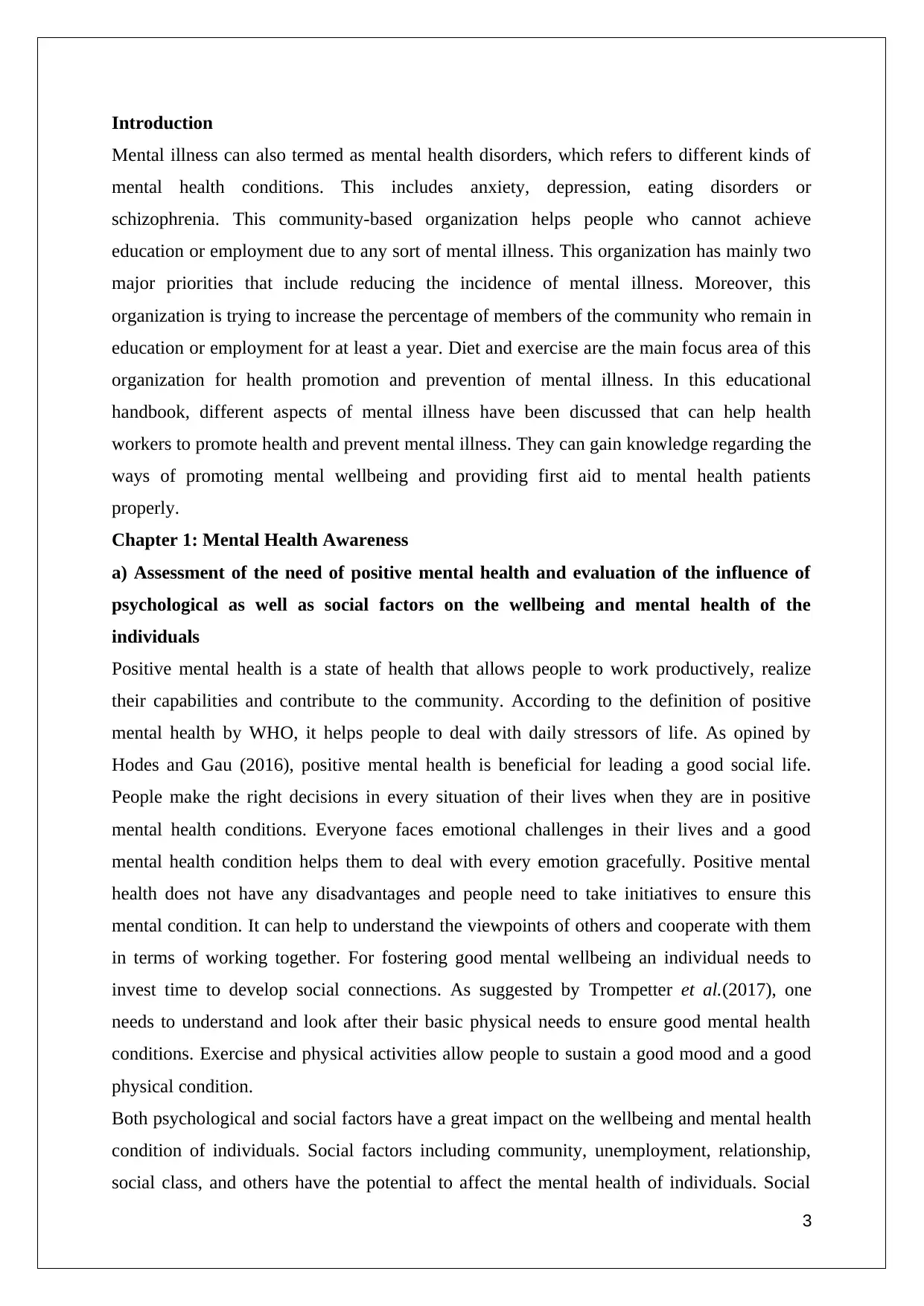
Introduction
Mental illness can also termed as mental health disorders, which refers to different kinds of
mental health conditions. This includes anxiety, depression, eating disorders or
schizophrenia. This community-based organization helps people who cannot achieve
education or employment due to any sort of mental illness. This organization has mainly two
major priorities that include reducing the incidence of mental illness. Moreover, this
organization is trying to increase the percentage of members of the community who remain in
education or employment for at least a year. Diet and exercise are the main focus area of this
organization for health promotion and prevention of mental illness. In this educational
handbook, different aspects of mental illness have been discussed that can help health
workers to promote health and prevent mental illness. They can gain knowledge regarding the
ways of promoting mental wellbeing and providing first aid to mental health patients
properly.
Chapter 1: Mental Health Awareness
a) Assessment of the need of positive mental health and evaluation of the influence of
psychological as well as social factors on the wellbeing and mental health of the
individuals
Positive mental health is a state of health that allows people to work productively, realize
their capabilities and contribute to the community. According to the definition of positive
mental health by WHO, it helps people to deal with daily stressors of life. As opined by
Hodes and Gau (2016), positive mental health is beneficial for leading a good social life.
People make the right decisions in every situation of their lives when they are in positive
mental health conditions. Everyone faces emotional challenges in their lives and a good
mental health condition helps them to deal with every emotion gracefully. Positive mental
health does not have any disadvantages and people need to take initiatives to ensure this
mental condition. It can help to understand the viewpoints of others and cooperate with them
in terms of working together. For fostering good mental wellbeing an individual needs to
invest time to develop social connections. As suggested by Trompetter et al.(2017), one
needs to understand and look after their basic physical needs to ensure good mental health
conditions. Exercise and physical activities allow people to sustain a good mood and a good
physical condition.
Both psychological and social factors have a great impact on the wellbeing and mental health
condition of individuals. Social factors including community, unemployment, relationship,
social class, and others have the potential to affect the mental health of individuals. Social
3
Mental illness can also termed as mental health disorders, which refers to different kinds of
mental health conditions. This includes anxiety, depression, eating disorders or
schizophrenia. This community-based organization helps people who cannot achieve
education or employment due to any sort of mental illness. This organization has mainly two
major priorities that include reducing the incidence of mental illness. Moreover, this
organization is trying to increase the percentage of members of the community who remain in
education or employment for at least a year. Diet and exercise are the main focus area of this
organization for health promotion and prevention of mental illness. In this educational
handbook, different aspects of mental illness have been discussed that can help health
workers to promote health and prevent mental illness. They can gain knowledge regarding the
ways of promoting mental wellbeing and providing first aid to mental health patients
properly.
Chapter 1: Mental Health Awareness
a) Assessment of the need of positive mental health and evaluation of the influence of
psychological as well as social factors on the wellbeing and mental health of the
individuals
Positive mental health is a state of health that allows people to work productively, realize
their capabilities and contribute to the community. According to the definition of positive
mental health by WHO, it helps people to deal with daily stressors of life. As opined by
Hodes and Gau (2016), positive mental health is beneficial for leading a good social life.
People make the right decisions in every situation of their lives when they are in positive
mental health conditions. Everyone faces emotional challenges in their lives and a good
mental health condition helps them to deal with every emotion gracefully. Positive mental
health does not have any disadvantages and people need to take initiatives to ensure this
mental condition. It can help to understand the viewpoints of others and cooperate with them
in terms of working together. For fostering good mental wellbeing an individual needs to
invest time to develop social connections. As suggested by Trompetter et al.(2017), one
needs to understand and look after their basic physical needs to ensure good mental health
conditions. Exercise and physical activities allow people to sustain a good mood and a good
physical condition.
Both psychological and social factors have a great impact on the wellbeing and mental health
condition of individuals. Social factors including community, unemployment, relationship,
social class, and others have the potential to affect the mental health of individuals. Social
3
⊘ This is a preview!⊘
Do you want full access?
Subscribe today to unlock all pages.

Trusted by 1+ million students worldwide
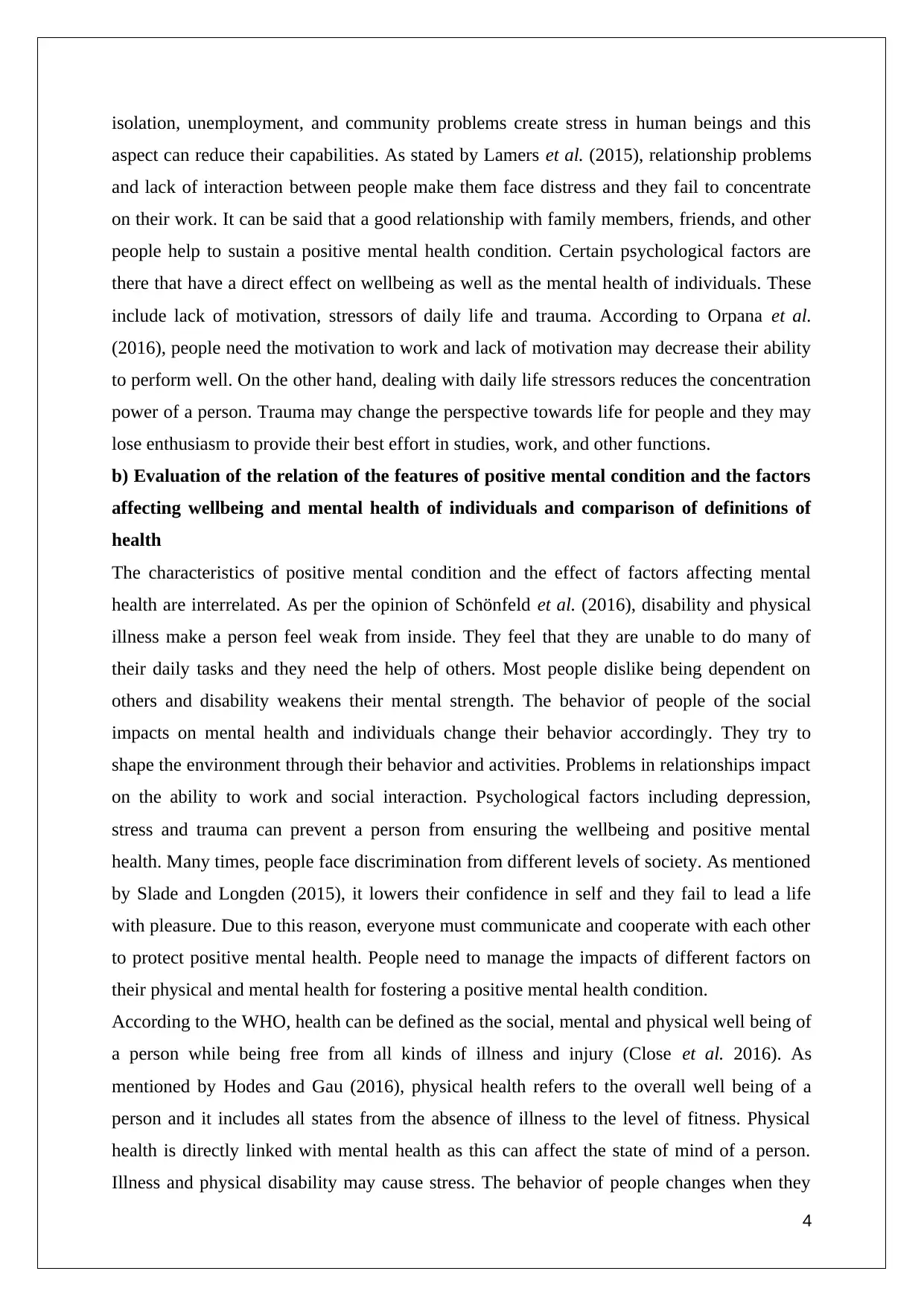
isolation, unemployment, and community problems create stress in human beings and this
aspect can reduce their capabilities. As stated by Lamers et al. (2015), relationship problems
and lack of interaction between people make them face distress and they fail to concentrate
on their work. It can be said that a good relationship with family members, friends, and other
people help to sustain a positive mental health condition. Certain psychological factors are
there that have a direct effect on wellbeing as well as the mental health of individuals. These
include lack of motivation, stressors of daily life and trauma. According to Orpana et al.
(2016), people need the motivation to work and lack of motivation may decrease their ability
to perform well. On the other hand, dealing with daily life stressors reduces the concentration
power of a person. Trauma may change the perspective towards life for people and they may
lose enthusiasm to provide their best effort in studies, work, and other functions.
b) Evaluation of the relation of the features of positive mental condition and the factors
affecting wellbeing and mental health of individuals and comparison of definitions of
health
The characteristics of positive mental condition and the effect of factors affecting mental
health are interrelated. As per the opinion of Schönfeld et al. (2016), disability and physical
illness make a person feel weak from inside. They feel that they are unable to do many of
their daily tasks and they need the help of others. Most people dislike being dependent on
others and disability weakens their mental strength. The behavior of people of the social
impacts on mental health and individuals change their behavior accordingly. They try to
shape the environment through their behavior and activities. Problems in relationships impact
on the ability to work and social interaction. Psychological factors including depression,
stress and trauma can prevent a person from ensuring the wellbeing and positive mental
health. Many times, people face discrimination from different levels of society. As mentioned
by Slade and Longden (2015), it lowers their confidence in self and they fail to lead a life
with pleasure. Due to this reason, everyone must communicate and cooperate with each other
to protect positive mental health. People need to manage the impacts of different factors on
their physical and mental health for fostering a positive mental health condition.
According to the WHO, health can be defined as the social, mental and physical well being of
a person while being free from all kinds of illness and injury (Close et al. 2016). As
mentioned by Hodes and Gau (2016), physical health refers to the overall well being of a
person and it includes all states from the absence of illness to the level of fitness. Physical
health is directly linked with mental health as this can affect the state of mind of a person.
Illness and physical disability may cause stress. The behavior of people changes when they
4
aspect can reduce their capabilities. As stated by Lamers et al. (2015), relationship problems
and lack of interaction between people make them face distress and they fail to concentrate
on their work. It can be said that a good relationship with family members, friends, and other
people help to sustain a positive mental health condition. Certain psychological factors are
there that have a direct effect on wellbeing as well as the mental health of individuals. These
include lack of motivation, stressors of daily life and trauma. According to Orpana et al.
(2016), people need the motivation to work and lack of motivation may decrease their ability
to perform well. On the other hand, dealing with daily life stressors reduces the concentration
power of a person. Trauma may change the perspective towards life for people and they may
lose enthusiasm to provide their best effort in studies, work, and other functions.
b) Evaluation of the relation of the features of positive mental condition and the factors
affecting wellbeing and mental health of individuals and comparison of definitions of
health
The characteristics of positive mental condition and the effect of factors affecting mental
health are interrelated. As per the opinion of Schönfeld et al. (2016), disability and physical
illness make a person feel weak from inside. They feel that they are unable to do many of
their daily tasks and they need the help of others. Most people dislike being dependent on
others and disability weakens their mental strength. The behavior of people of the social
impacts on mental health and individuals change their behavior accordingly. They try to
shape the environment through their behavior and activities. Problems in relationships impact
on the ability to work and social interaction. Psychological factors including depression,
stress and trauma can prevent a person from ensuring the wellbeing and positive mental
health. Many times, people face discrimination from different levels of society. As mentioned
by Slade and Longden (2015), it lowers their confidence in self and they fail to lead a life
with pleasure. Due to this reason, everyone must communicate and cooperate with each other
to protect positive mental health. People need to manage the impacts of different factors on
their physical and mental health for fostering a positive mental health condition.
According to the WHO, health can be defined as the social, mental and physical well being of
a person while being free from all kinds of illness and injury (Close et al. 2016). As
mentioned by Hodes and Gau (2016), physical health refers to the overall well being of a
person and it includes all states from the absence of illness to the level of fitness. Physical
health is directly linked with mental health as this can affect the state of mind of a person.
Illness and physical disability may cause stress. The behavior of people changes when they
4
Paraphrase This Document
Need a fresh take? Get an instant paraphrase of this document with our AI Paraphraser
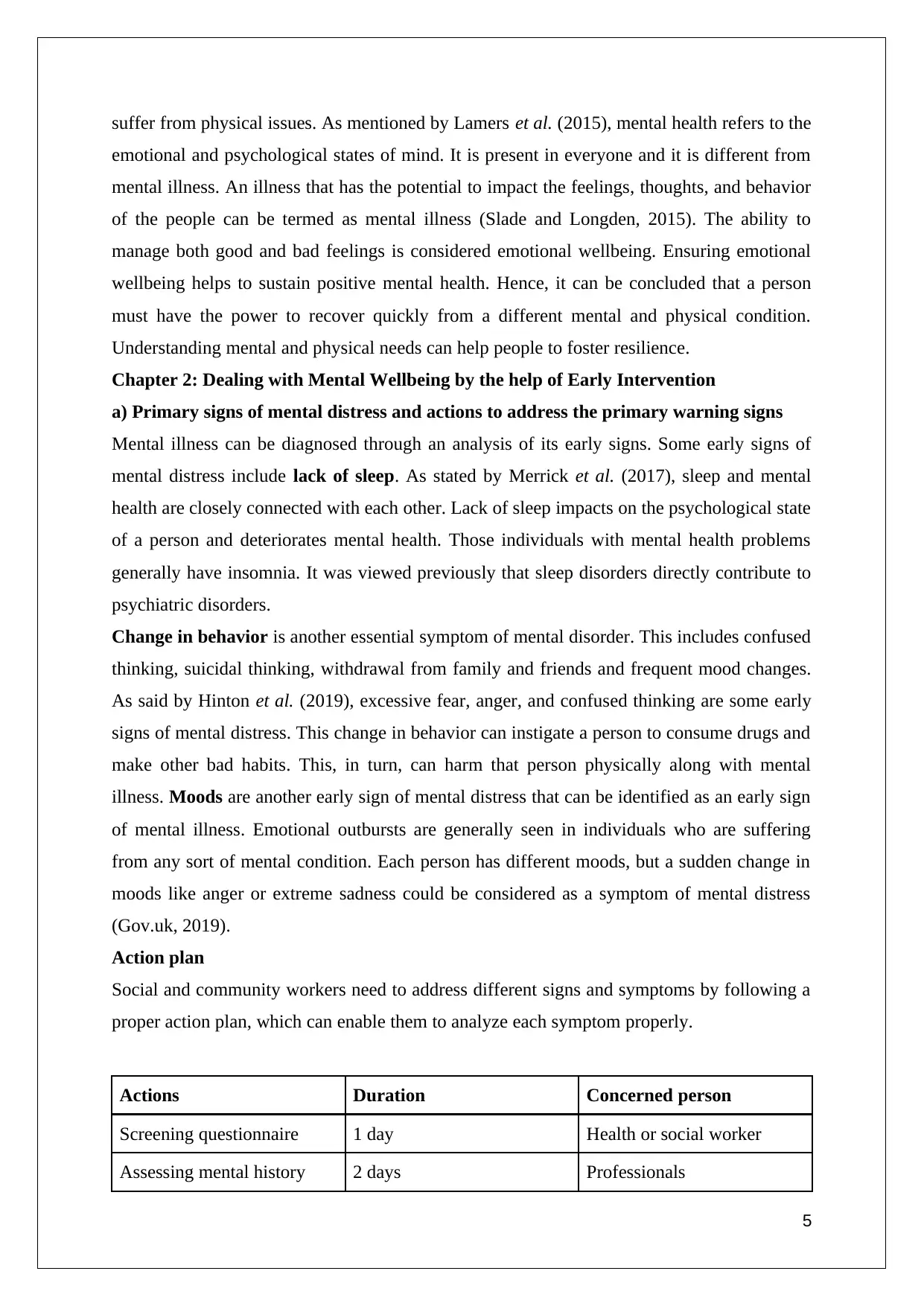
suffer from physical issues. As mentioned by Lamers et al. (2015), mental health refers to the
emotional and psychological states of mind. It is present in everyone and it is different from
mental illness. An illness that has the potential to impact the feelings, thoughts, and behavior
of the people can be termed as mental illness (Slade and Longden, 2015). The ability to
manage both good and bad feelings is considered emotional wellbeing. Ensuring emotional
wellbeing helps to sustain positive mental health. Hence, it can be concluded that a person
must have the power to recover quickly from a different mental and physical condition.
Understanding mental and physical needs can help people to foster resilience.
Chapter 2: Dealing with Mental Wellbeing by the help of Early Intervention
a) Primary signs of mental distress and actions to address the primary warning signs
Mental illness can be diagnosed through an analysis of its early signs. Some early signs of
mental distress include lack of sleep. As stated by Merrick et al. (2017), sleep and mental
health are closely connected with each other. Lack of sleep impacts on the psychological state
of a person and deteriorates mental health. Those individuals with mental health problems
generally have insomnia. It was viewed previously that sleep disorders directly contribute to
psychiatric disorders.
Change in behavior is another essential symptom of mental disorder. This includes confused
thinking, suicidal thinking, withdrawal from family and friends and frequent mood changes.
As said by Hinton et al. (2019), excessive fear, anger, and confused thinking are some early
signs of mental distress. This change in behavior can instigate a person to consume drugs and
make other bad habits. This, in turn, can harm that person physically along with mental
illness. Moods are another early sign of mental distress that can be identified as an early sign
of mental illness. Emotional outbursts are generally seen in individuals who are suffering
from any sort of mental condition. Each person has different moods, but a sudden change in
moods like anger or extreme sadness could be considered as a symptom of mental distress
(Gov.uk, 2019).
Action plan
Social and community workers need to address different signs and symptoms by following a
proper action plan, which can enable them to analyze each symptom properly.
Actions Duration Concerned person
Screening questionnaire 1 day Health or social worker
Assessing mental history 2 days Professionals
5
emotional and psychological states of mind. It is present in everyone and it is different from
mental illness. An illness that has the potential to impact the feelings, thoughts, and behavior
of the people can be termed as mental illness (Slade and Longden, 2015). The ability to
manage both good and bad feelings is considered emotional wellbeing. Ensuring emotional
wellbeing helps to sustain positive mental health. Hence, it can be concluded that a person
must have the power to recover quickly from a different mental and physical condition.
Understanding mental and physical needs can help people to foster resilience.
Chapter 2: Dealing with Mental Wellbeing by the help of Early Intervention
a) Primary signs of mental distress and actions to address the primary warning signs
Mental illness can be diagnosed through an analysis of its early signs. Some early signs of
mental distress include lack of sleep. As stated by Merrick et al. (2017), sleep and mental
health are closely connected with each other. Lack of sleep impacts on the psychological state
of a person and deteriorates mental health. Those individuals with mental health problems
generally have insomnia. It was viewed previously that sleep disorders directly contribute to
psychiatric disorders.
Change in behavior is another essential symptom of mental disorder. This includes confused
thinking, suicidal thinking, withdrawal from family and friends and frequent mood changes.
As said by Hinton et al. (2019), excessive fear, anger, and confused thinking are some early
signs of mental distress. This change in behavior can instigate a person to consume drugs and
make other bad habits. This, in turn, can harm that person physically along with mental
illness. Moods are another early sign of mental distress that can be identified as an early sign
of mental illness. Emotional outbursts are generally seen in individuals who are suffering
from any sort of mental condition. Each person has different moods, but a sudden change in
moods like anger or extreme sadness could be considered as a symptom of mental distress
(Gov.uk, 2019).
Action plan
Social and community workers need to address different signs and symptoms by following a
proper action plan, which can enable them to analyze each symptom properly.
Actions Duration Concerned person
Screening questionnaire 1 day Health or social worker
Assessing mental history 2 days Professionals
5
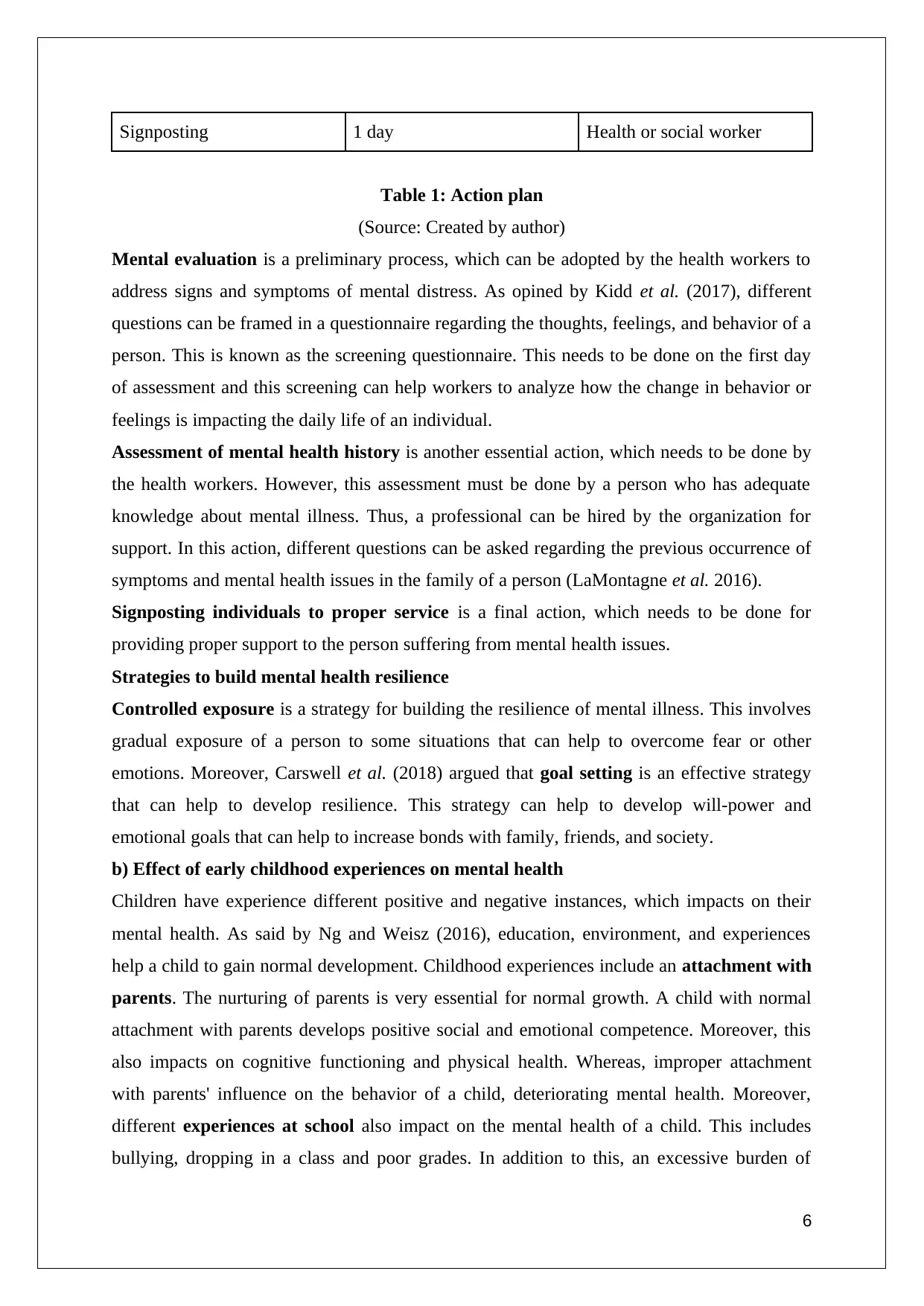
Signposting 1 day Health or social worker
Table 1: Action plan
(Source: Created by author)
Mental evaluation is a preliminary process, which can be adopted by the health workers to
address signs and symptoms of mental distress. As opined by Kidd et al. (2017), different
questions can be framed in a questionnaire regarding the thoughts, feelings, and behavior of a
person. This is known as the screening questionnaire. This needs to be done on the first day
of assessment and this screening can help workers to analyze how the change in behavior or
feelings is impacting the daily life of an individual.
Assessment of mental health history is another essential action, which needs to be done by
the health workers. However, this assessment must be done by a person who has adequate
knowledge about mental illness. Thus, a professional can be hired by the organization for
support. In this action, different questions can be asked regarding the previous occurrence of
symptoms and mental health issues in the family of a person (LaMontagne et al. 2016).
Signposting individuals to proper service is a final action, which needs to be done for
providing proper support to the person suffering from mental health issues.
Strategies to build mental health resilience
Controlled exposure is a strategy for building the resilience of mental illness. This involves
gradual exposure of a person to some situations that can help to overcome fear or other
emotions. Moreover, Carswell et al. (2018) argued that goal setting is an effective strategy
that can help to develop resilience. This strategy can help to develop will-power and
emotional goals that can help to increase bonds with family, friends, and society.
b) Effect of early childhood experiences on mental health
Children have experience different positive and negative instances, which impacts on their
mental health. As said by Ng and Weisz (2016), education, environment, and experiences
help a child to gain normal development. Childhood experiences include an attachment with
parents. The nurturing of parents is very essential for normal growth. A child with normal
attachment with parents develops positive social and emotional competence. Moreover, this
also impacts on cognitive functioning and physical health. Whereas, improper attachment
with parents' influence on the behavior of a child, deteriorating mental health. Moreover,
different experiences at school also impact on the mental health of a child. This includes
bullying, dropping in a class and poor grades. In addition to this, an excessive burden of
6
Table 1: Action plan
(Source: Created by author)
Mental evaluation is a preliminary process, which can be adopted by the health workers to
address signs and symptoms of mental distress. As opined by Kidd et al. (2017), different
questions can be framed in a questionnaire regarding the thoughts, feelings, and behavior of a
person. This is known as the screening questionnaire. This needs to be done on the first day
of assessment and this screening can help workers to analyze how the change in behavior or
feelings is impacting the daily life of an individual.
Assessment of mental health history is another essential action, which needs to be done by
the health workers. However, this assessment must be done by a person who has adequate
knowledge about mental illness. Thus, a professional can be hired by the organization for
support. In this action, different questions can be asked regarding the previous occurrence of
symptoms and mental health issues in the family of a person (LaMontagne et al. 2016).
Signposting individuals to proper service is a final action, which needs to be done for
providing proper support to the person suffering from mental health issues.
Strategies to build mental health resilience
Controlled exposure is a strategy for building the resilience of mental illness. This involves
gradual exposure of a person to some situations that can help to overcome fear or other
emotions. Moreover, Carswell et al. (2018) argued that goal setting is an effective strategy
that can help to develop resilience. This strategy can help to develop will-power and
emotional goals that can help to increase bonds with family, friends, and society.
b) Effect of early childhood experiences on mental health
Children have experience different positive and negative instances, which impacts on their
mental health. As said by Ng and Weisz (2016), education, environment, and experiences
help a child to gain normal development. Childhood experiences include an attachment with
parents. The nurturing of parents is very essential for normal growth. A child with normal
attachment with parents develops positive social and emotional competence. Moreover, this
also impacts on cognitive functioning and physical health. Whereas, improper attachment
with parents' influence on the behavior of a child, deteriorating mental health. Moreover,
different experiences at school also impact on the mental health of a child. This includes
bullying, dropping in a class and poor grades. In addition to this, an excessive burden of
6
⊘ This is a preview!⊘
Do you want full access?
Subscribe today to unlock all pages.

Trusted by 1+ million students worldwide
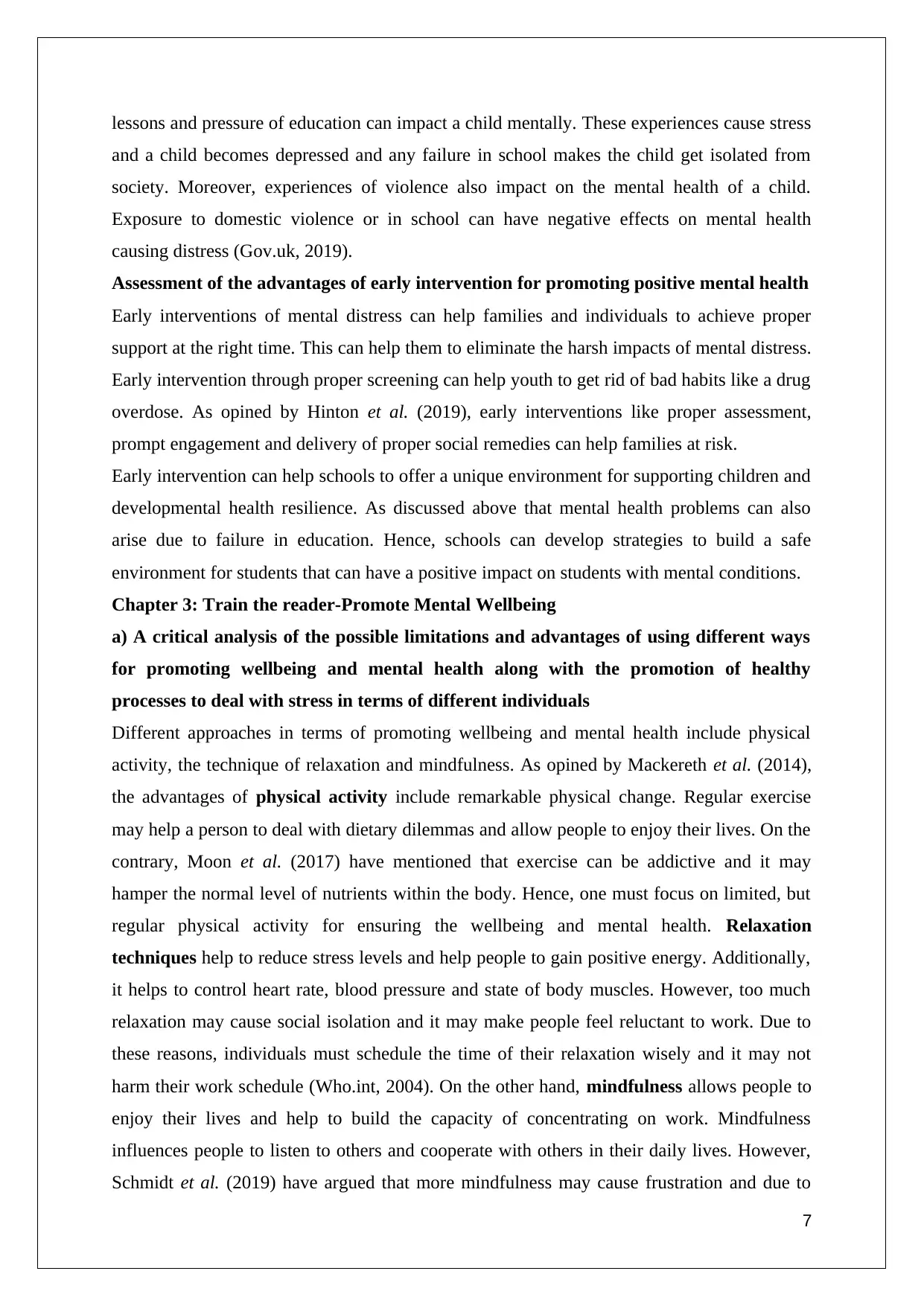
lessons and pressure of education can impact a child mentally. These experiences cause stress
and a child becomes depressed and any failure in school makes the child get isolated from
society. Moreover, experiences of violence also impact on the mental health of a child.
Exposure to domestic violence or in school can have negative effects on mental health
causing distress (Gov.uk, 2019).
Assessment of the advantages of early intervention for promoting positive mental health
Early interventions of mental distress can help families and individuals to achieve proper
support at the right time. This can help them to eliminate the harsh impacts of mental distress.
Early intervention through proper screening can help youth to get rid of bad habits like a drug
overdose. As opined by Hinton et al. (2019), early interventions like proper assessment,
prompt engagement and delivery of proper social remedies can help families at risk.
Early intervention can help schools to offer a unique environment for supporting children and
developmental health resilience. As discussed above that mental health problems can also
arise due to failure in education. Hence, schools can develop strategies to build a safe
environment for students that can have a positive impact on students with mental conditions.
Chapter 3: Train the reader-Promote Mental Wellbeing
a) A critical analysis of the possible limitations and advantages of using different ways
for promoting wellbeing and mental health along with the promotion of healthy
processes to deal with stress in terms of different individuals
Different approaches in terms of promoting wellbeing and mental health include physical
activity, the technique of relaxation and mindfulness. As opined by Mackereth et al. (2014),
the advantages of physical activity include remarkable physical change. Regular exercise
may help a person to deal with dietary dilemmas and allow people to enjoy their lives. On the
contrary, Moon et al. (2017) have mentioned that exercise can be addictive and it may
hamper the normal level of nutrients within the body. Hence, one must focus on limited, but
regular physical activity for ensuring the wellbeing and mental health. Relaxation
techniques help to reduce stress levels and help people to gain positive energy. Additionally,
it helps to control heart rate, blood pressure and state of body muscles. However, too much
relaxation may cause social isolation and it may make people feel reluctant to work. Due to
these reasons, individuals must schedule the time of their relaxation wisely and it may not
harm their work schedule (Who.int, 2004). On the other hand, mindfulness allows people to
enjoy their lives and help to build the capacity of concentrating on work. Mindfulness
influences people to listen to others and cooperate with others in their daily lives. However,
Schmidt et al. (2019) have argued that more mindfulness may cause frustration and due to
7
and a child becomes depressed and any failure in school makes the child get isolated from
society. Moreover, experiences of violence also impact on the mental health of a child.
Exposure to domestic violence or in school can have negative effects on mental health
causing distress (Gov.uk, 2019).
Assessment of the advantages of early intervention for promoting positive mental health
Early interventions of mental distress can help families and individuals to achieve proper
support at the right time. This can help them to eliminate the harsh impacts of mental distress.
Early intervention through proper screening can help youth to get rid of bad habits like a drug
overdose. As opined by Hinton et al. (2019), early interventions like proper assessment,
prompt engagement and delivery of proper social remedies can help families at risk.
Early intervention can help schools to offer a unique environment for supporting children and
developmental health resilience. As discussed above that mental health problems can also
arise due to failure in education. Hence, schools can develop strategies to build a safe
environment for students that can have a positive impact on students with mental conditions.
Chapter 3: Train the reader-Promote Mental Wellbeing
a) A critical analysis of the possible limitations and advantages of using different ways
for promoting wellbeing and mental health along with the promotion of healthy
processes to deal with stress in terms of different individuals
Different approaches in terms of promoting wellbeing and mental health include physical
activity, the technique of relaxation and mindfulness. As opined by Mackereth et al. (2014),
the advantages of physical activity include remarkable physical change. Regular exercise
may help a person to deal with dietary dilemmas and allow people to enjoy their lives. On the
contrary, Moon et al. (2017) have mentioned that exercise can be addictive and it may
hamper the normal level of nutrients within the body. Hence, one must focus on limited, but
regular physical activity for ensuring the wellbeing and mental health. Relaxation
techniques help to reduce stress levels and help people to gain positive energy. Additionally,
it helps to control heart rate, blood pressure and state of body muscles. However, too much
relaxation may cause social isolation and it may make people feel reluctant to work. Due to
these reasons, individuals must schedule the time of their relaxation wisely and it may not
harm their work schedule (Who.int, 2004). On the other hand, mindfulness allows people to
enjoy their lives and help to build the capacity of concentrating on work. Mindfulness
influences people to listen to others and cooperate with others in their daily lives. However,
Schmidt et al. (2019) have argued that more mindfulness may cause frustration and due to
7
Paraphrase This Document
Need a fresh take? Get an instant paraphrase of this document with our AI Paraphraser
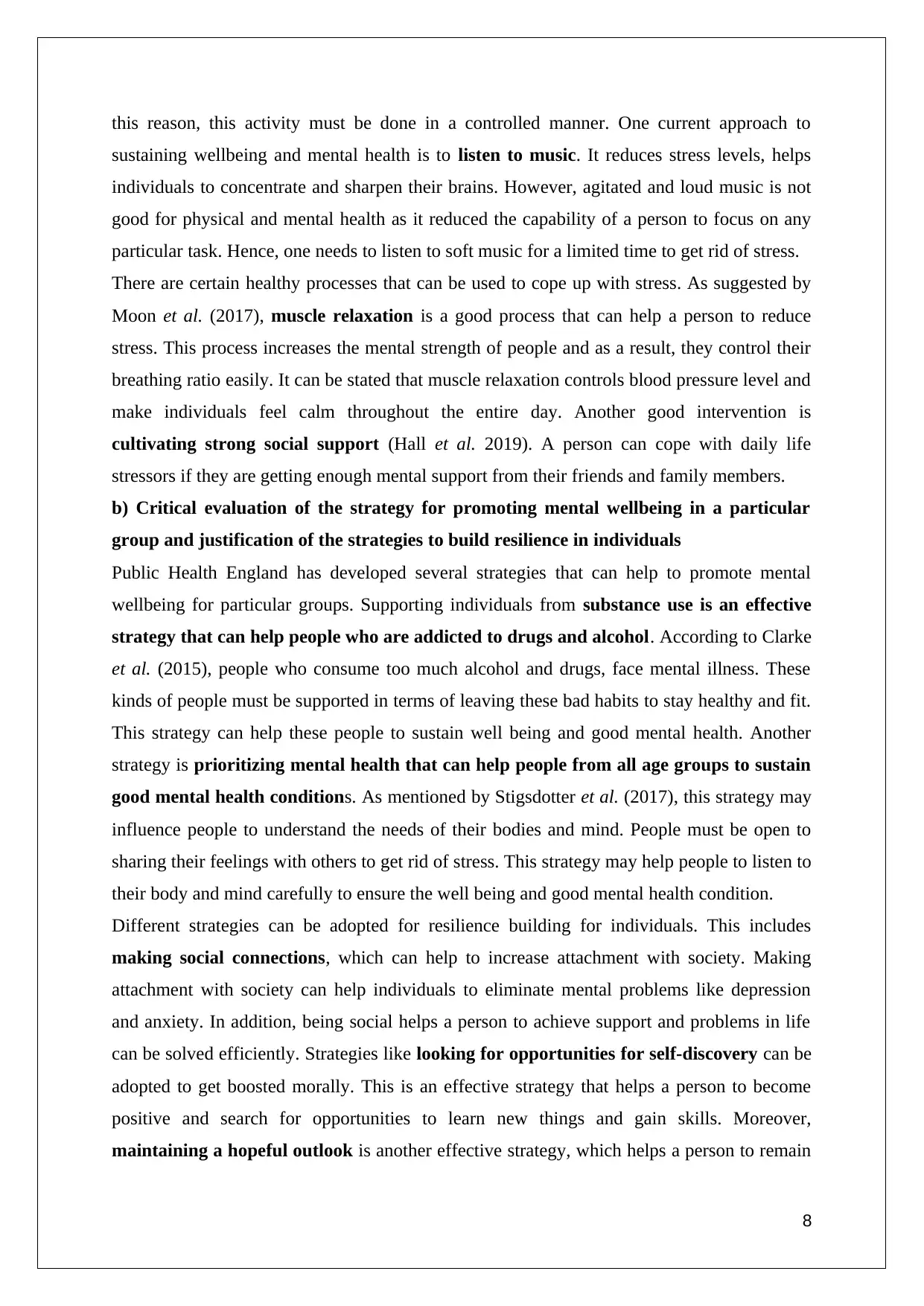
this reason, this activity must be done in a controlled manner. One current approach to
sustaining wellbeing and mental health is to listen to music. It reduces stress levels, helps
individuals to concentrate and sharpen their brains. However, agitated and loud music is not
good for physical and mental health as it reduced the capability of a person to focus on any
particular task. Hence, one needs to listen to soft music for a limited time to get rid of stress.
There are certain healthy processes that can be used to cope up with stress. As suggested by
Moon et al. (2017), muscle relaxation is a good process that can help a person to reduce
stress. This process increases the mental strength of people and as a result, they control their
breathing ratio easily. It can be stated that muscle relaxation controls blood pressure level and
make individuals feel calm throughout the entire day. Another good intervention is
cultivating strong social support (Hall et al. 2019). A person can cope with daily life
stressors if they are getting enough mental support from their friends and family members.
b) Critical evaluation of the strategy for promoting mental wellbeing in a particular
group and justification of the strategies to build resilience in individuals
Public Health England has developed several strategies that can help to promote mental
wellbeing for particular groups. Supporting individuals from substance use is an effective
strategy that can help people who are addicted to drugs and alcohol. According to Clarke
et al. (2015), people who consume too much alcohol and drugs, face mental illness. These
kinds of people must be supported in terms of leaving these bad habits to stay healthy and fit.
This strategy can help these people to sustain well being and good mental health. Another
strategy is prioritizing mental health that can help people from all age groups to sustain
good mental health conditions. As mentioned by Stigsdotter et al. (2017), this strategy may
influence people to understand the needs of their bodies and mind. People must be open to
sharing their feelings with others to get rid of stress. This strategy may help people to listen to
their body and mind carefully to ensure the well being and good mental health condition.
Different strategies can be adopted for resilience building for individuals. This includes
making social connections, which can help to increase attachment with society. Making
attachment with society can help individuals to eliminate mental problems like depression
and anxiety. In addition, being social helps a person to achieve support and problems in life
can be solved efficiently. Strategies like looking for opportunities for self-discovery can be
adopted to get boosted morally. This is an effective strategy that helps a person to become
positive and search for opportunities to learn new things and gain skills. Moreover,
maintaining a hopeful outlook is another effective strategy, which helps a person to remain
8
sustaining wellbeing and mental health is to listen to music. It reduces stress levels, helps
individuals to concentrate and sharpen their brains. However, agitated and loud music is not
good for physical and mental health as it reduced the capability of a person to focus on any
particular task. Hence, one needs to listen to soft music for a limited time to get rid of stress.
There are certain healthy processes that can be used to cope up with stress. As suggested by
Moon et al. (2017), muscle relaxation is a good process that can help a person to reduce
stress. This process increases the mental strength of people and as a result, they control their
breathing ratio easily. It can be stated that muscle relaxation controls blood pressure level and
make individuals feel calm throughout the entire day. Another good intervention is
cultivating strong social support (Hall et al. 2019). A person can cope with daily life
stressors if they are getting enough mental support from their friends and family members.
b) Critical evaluation of the strategy for promoting mental wellbeing in a particular
group and justification of the strategies to build resilience in individuals
Public Health England has developed several strategies that can help to promote mental
wellbeing for particular groups. Supporting individuals from substance use is an effective
strategy that can help people who are addicted to drugs and alcohol. According to Clarke
et al. (2015), people who consume too much alcohol and drugs, face mental illness. These
kinds of people must be supported in terms of leaving these bad habits to stay healthy and fit.
This strategy can help these people to sustain well being and good mental health. Another
strategy is prioritizing mental health that can help people from all age groups to sustain
good mental health conditions. As mentioned by Stigsdotter et al. (2017), this strategy may
influence people to understand the needs of their bodies and mind. People must be open to
sharing their feelings with others to get rid of stress. This strategy may help people to listen to
their body and mind carefully to ensure the well being and good mental health condition.
Different strategies can be adopted for resilience building for individuals. This includes
making social connections, which can help to increase attachment with society. Making
attachment with society can help individuals to eliminate mental problems like depression
and anxiety. In addition, being social helps a person to achieve support and problems in life
can be solved efficiently. Strategies like looking for opportunities for self-discovery can be
adopted to get boosted morally. This is an effective strategy that helps a person to become
positive and search for opportunities to learn new things and gain skills. Moreover,
maintaining a hopeful outlook is another effective strategy, which helps a person to remain
8
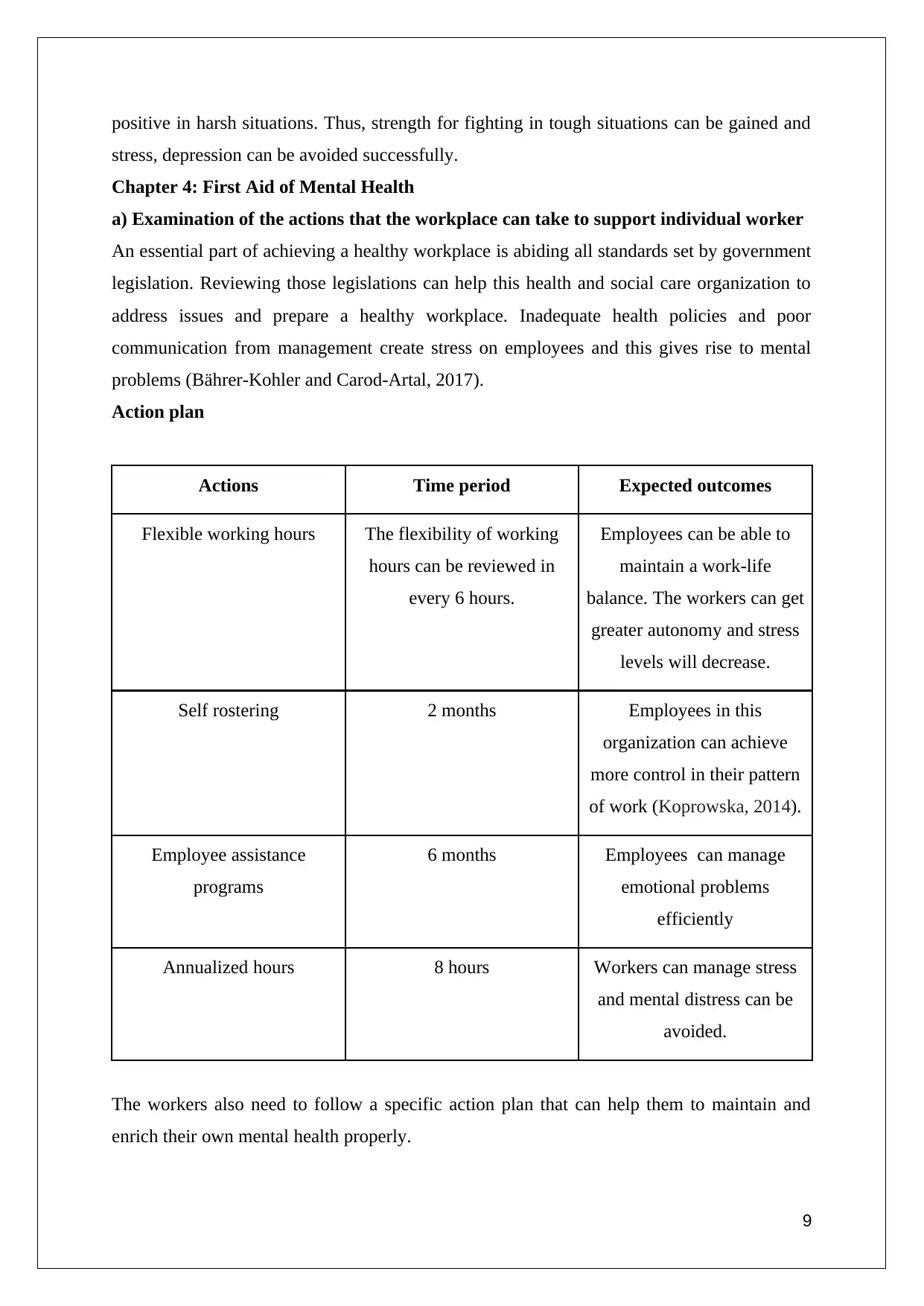
positive in harsh situations. Thus, strength for fighting in tough situations can be gained and
stress, depression can be avoided successfully.
Chapter 4: First Aid of Mental Health
a) Examination of the actions that the workplace can take to support individual worker
An essential part of achieving a healthy workplace is abiding all standards set by government
legislation. Reviewing those legislations can help this health and social care organization to
address issues and prepare a healthy workplace. Inadequate health policies and poor
communication from management create stress on employees and this gives rise to mental
problems (Bährer-Kohler and Carod-Artal, 2017).
Action plan
Actions Time period Expected outcomes
Flexible working hours The flexibility of working
hours can be reviewed in
every 6 hours.
Employees can be able to
maintain a work-life
balance. The workers can get
greater autonomy and stress
levels will decrease.
Self rostering 2 months Employees in this
organization can achieve
more control in their pattern
of work (Koprowska, 2014).
Employee assistance
programs
6 months Employees can manage
emotional problems
efficiently
Annualized hours 8 hours Workers can manage stress
and mental distress can be
avoided.
The workers also need to follow a specific action plan that can help them to maintain and
enrich their own mental health properly.
9
stress, depression can be avoided successfully.
Chapter 4: First Aid of Mental Health
a) Examination of the actions that the workplace can take to support individual worker
An essential part of achieving a healthy workplace is abiding all standards set by government
legislation. Reviewing those legislations can help this health and social care organization to
address issues and prepare a healthy workplace. Inadequate health policies and poor
communication from management create stress on employees and this gives rise to mental
problems (Bährer-Kohler and Carod-Artal, 2017).
Action plan
Actions Time period Expected outcomes
Flexible working hours The flexibility of working
hours can be reviewed in
every 6 hours.
Employees can be able to
maintain a work-life
balance. The workers can get
greater autonomy and stress
levels will decrease.
Self rostering 2 months Employees in this
organization can achieve
more control in their pattern
of work (Koprowska, 2014).
Employee assistance
programs
6 months Employees can manage
emotional problems
efficiently
Annualized hours 8 hours Workers can manage stress
and mental distress can be
avoided.
The workers also need to follow a specific action plan that can help them to maintain and
enrich their own mental health properly.
9
⊘ This is a preview!⊘
Do you want full access?
Subscribe today to unlock all pages.

Trusted by 1+ million students worldwide
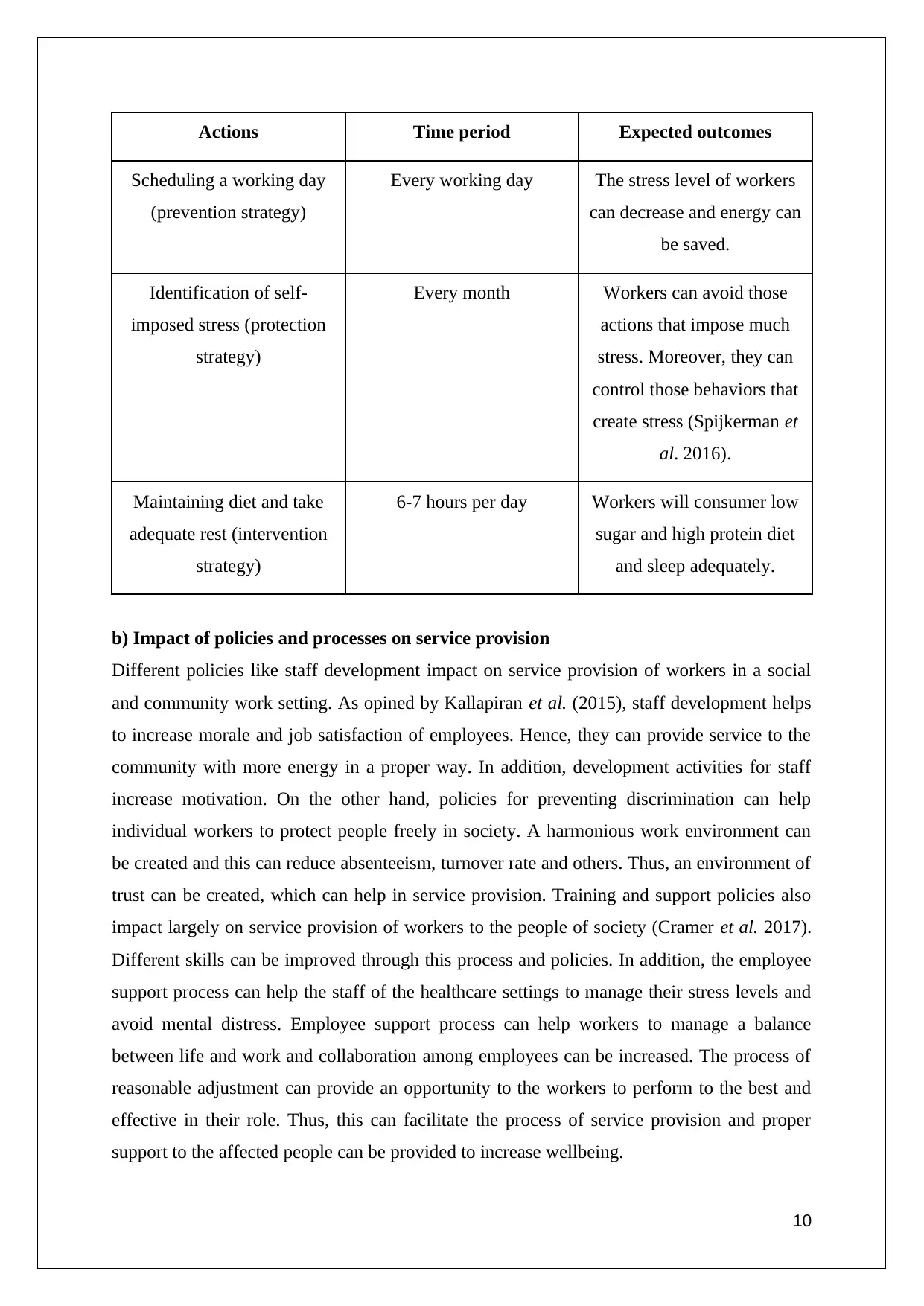
Actions Time period Expected outcomes
Scheduling a working day
(prevention strategy)
Every working day The stress level of workers
can decrease and energy can
be saved.
Identification of self-
imposed stress (protection
strategy)
Every month Workers can avoid those
actions that impose much
stress. Moreover, they can
control those behaviors that
create stress (Spijkerman et
al. 2016).
Maintaining diet and take
adequate rest (intervention
strategy)
6-7 hours per day Workers will consumer low
sugar and high protein diet
and sleep adequately.
b) Impact of policies and processes on service provision
Different policies like staff development impact on service provision of workers in a social
and community work setting. As opined by Kallapiran et al. (2015), staff development helps
to increase morale and job satisfaction of employees. Hence, they can provide service to the
community with more energy in a proper way. In addition, development activities for staff
increase motivation. On the other hand, policies for preventing discrimination can help
individual workers to protect people freely in society. A harmonious work environment can
be created and this can reduce absenteeism, turnover rate and others. Thus, an environment of
trust can be created, which can help in service provision. Training and support policies also
impact largely on service provision of workers to the people of society (Cramer et al. 2017).
Different skills can be improved through this process and policies. In addition, the employee
support process can help the staff of the healthcare settings to manage their stress levels and
avoid mental distress. Employee support process can help workers to manage a balance
between life and work and collaboration among employees can be increased. The process of
reasonable adjustment can provide an opportunity to the workers to perform to the best and
effective in their role. Thus, this can facilitate the process of service provision and proper
support to the affected people can be provided to increase wellbeing.
10
Scheduling a working day
(prevention strategy)
Every working day The stress level of workers
can decrease and energy can
be saved.
Identification of self-
imposed stress (protection
strategy)
Every month Workers can avoid those
actions that impose much
stress. Moreover, they can
control those behaviors that
create stress (Spijkerman et
al. 2016).
Maintaining diet and take
adequate rest (intervention
strategy)
6-7 hours per day Workers will consumer low
sugar and high protein diet
and sleep adequately.
b) Impact of policies and processes on service provision
Different policies like staff development impact on service provision of workers in a social
and community work setting. As opined by Kallapiran et al. (2015), staff development helps
to increase morale and job satisfaction of employees. Hence, they can provide service to the
community with more energy in a proper way. In addition, development activities for staff
increase motivation. On the other hand, policies for preventing discrimination can help
individual workers to protect people freely in society. A harmonious work environment can
be created and this can reduce absenteeism, turnover rate and others. Thus, an environment of
trust can be created, which can help in service provision. Training and support policies also
impact largely on service provision of workers to the people of society (Cramer et al. 2017).
Different skills can be improved through this process and policies. In addition, the employee
support process can help the staff of the healthcare settings to manage their stress levels and
avoid mental distress. Employee support process can help workers to manage a balance
between life and work and collaboration among employees can be increased. The process of
reasonable adjustment can provide an opportunity to the workers to perform to the best and
effective in their role. Thus, this can facilitate the process of service provision and proper
support to the affected people can be provided to increase wellbeing.
10
Paraphrase This Document
Need a fresh take? Get an instant paraphrase of this document with our AI Paraphraser
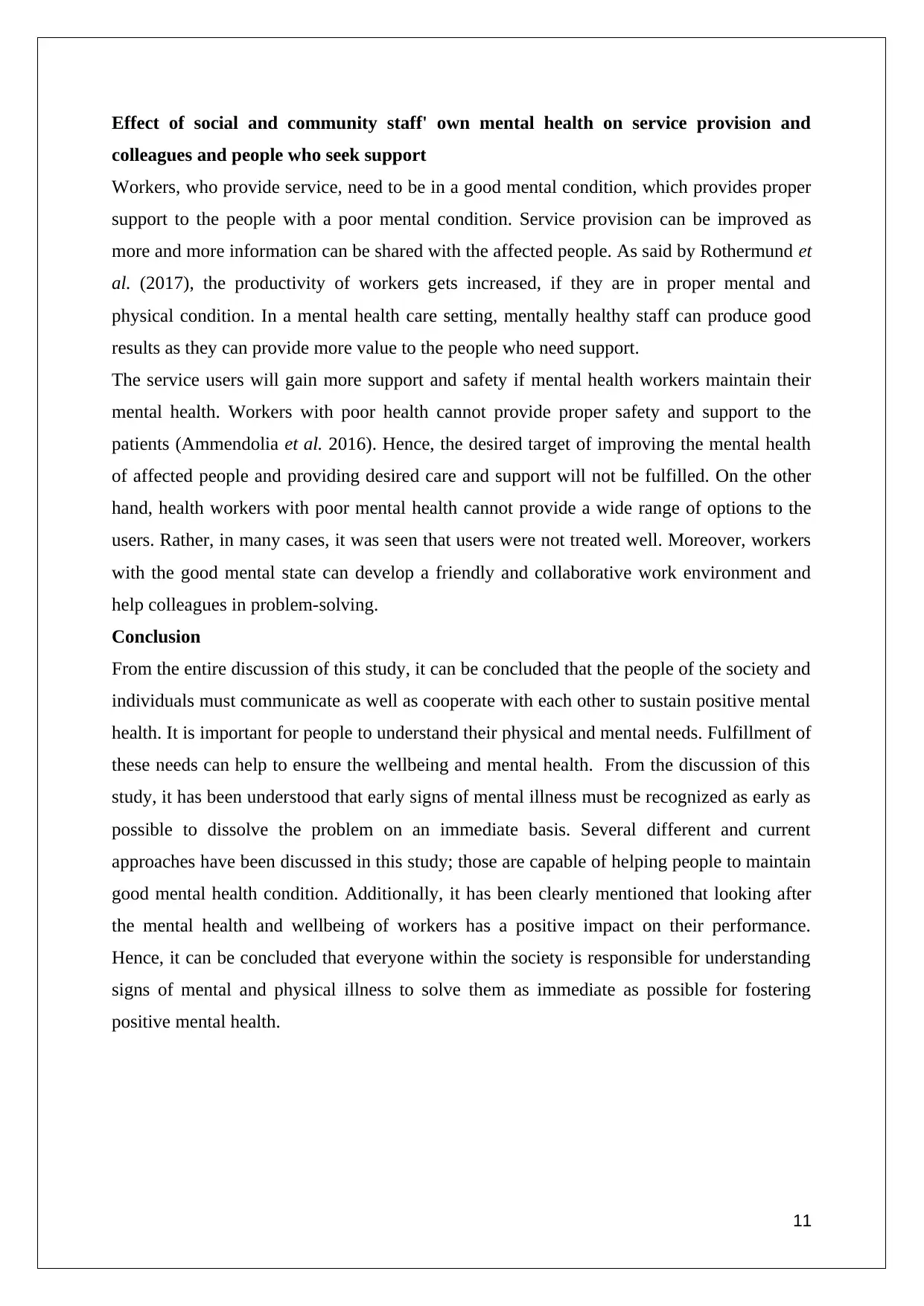
Effect of social and community staff' own mental health on service provision and
colleagues and people who seek support
Workers, who provide service, need to be in a good mental condition, which provides proper
support to the people with a poor mental condition. Service provision can be improved as
more and more information can be shared with the affected people. As said by Rothermund et
al. (2017), the productivity of workers gets increased, if they are in proper mental and
physical condition. In a mental health care setting, mentally healthy staff can produce good
results as they can provide more value to the people who need support.
The service users will gain more support and safety if mental health workers maintain their
mental health. Workers with poor health cannot provide proper safety and support to the
patients (Ammendolia et al. 2016). Hence, the desired target of improving the mental health
of affected people and providing desired care and support will not be fulfilled. On the other
hand, health workers with poor mental health cannot provide a wide range of options to the
users. Rather, in many cases, it was seen that users were not treated well. Moreover, workers
with the good mental state can develop a friendly and collaborative work environment and
help colleagues in problem-solving.
Conclusion
From the entire discussion of this study, it can be concluded that the people of the society and
individuals must communicate as well as cooperate with each other to sustain positive mental
health. It is important for people to understand their physical and mental needs. Fulfillment of
these needs can help to ensure the wellbeing and mental health. From the discussion of this
study, it has been understood that early signs of mental illness must be recognized as early as
possible to dissolve the problem on an immediate basis. Several different and current
approaches have been discussed in this study; those are capable of helping people to maintain
good mental health condition. Additionally, it has been clearly mentioned that looking after
the mental health and wellbeing of workers has a positive impact on their performance.
Hence, it can be concluded that everyone within the society is responsible for understanding
signs of mental and physical illness to solve them as immediate as possible for fostering
positive mental health.
11
colleagues and people who seek support
Workers, who provide service, need to be in a good mental condition, which provides proper
support to the people with a poor mental condition. Service provision can be improved as
more and more information can be shared with the affected people. As said by Rothermund et
al. (2017), the productivity of workers gets increased, if they are in proper mental and
physical condition. In a mental health care setting, mentally healthy staff can produce good
results as they can provide more value to the people who need support.
The service users will gain more support and safety if mental health workers maintain their
mental health. Workers with poor health cannot provide proper safety and support to the
patients (Ammendolia et al. 2016). Hence, the desired target of improving the mental health
of affected people and providing desired care and support will not be fulfilled. On the other
hand, health workers with poor mental health cannot provide a wide range of options to the
users. Rather, in many cases, it was seen that users were not treated well. Moreover, workers
with the good mental state can develop a friendly and collaborative work environment and
help colleagues in problem-solving.
Conclusion
From the entire discussion of this study, it can be concluded that the people of the society and
individuals must communicate as well as cooperate with each other to sustain positive mental
health. It is important for people to understand their physical and mental needs. Fulfillment of
these needs can help to ensure the wellbeing and mental health. From the discussion of this
study, it has been understood that early signs of mental illness must be recognized as early as
possible to dissolve the problem on an immediate basis. Several different and current
approaches have been discussed in this study; those are capable of helping people to maintain
good mental health condition. Additionally, it has been clearly mentioned that looking after
the mental health and wellbeing of workers has a positive impact on their performance.
Hence, it can be concluded that everyone within the society is responsible for understanding
signs of mental and physical illness to solve them as immediate as possible for fostering
positive mental health.
11
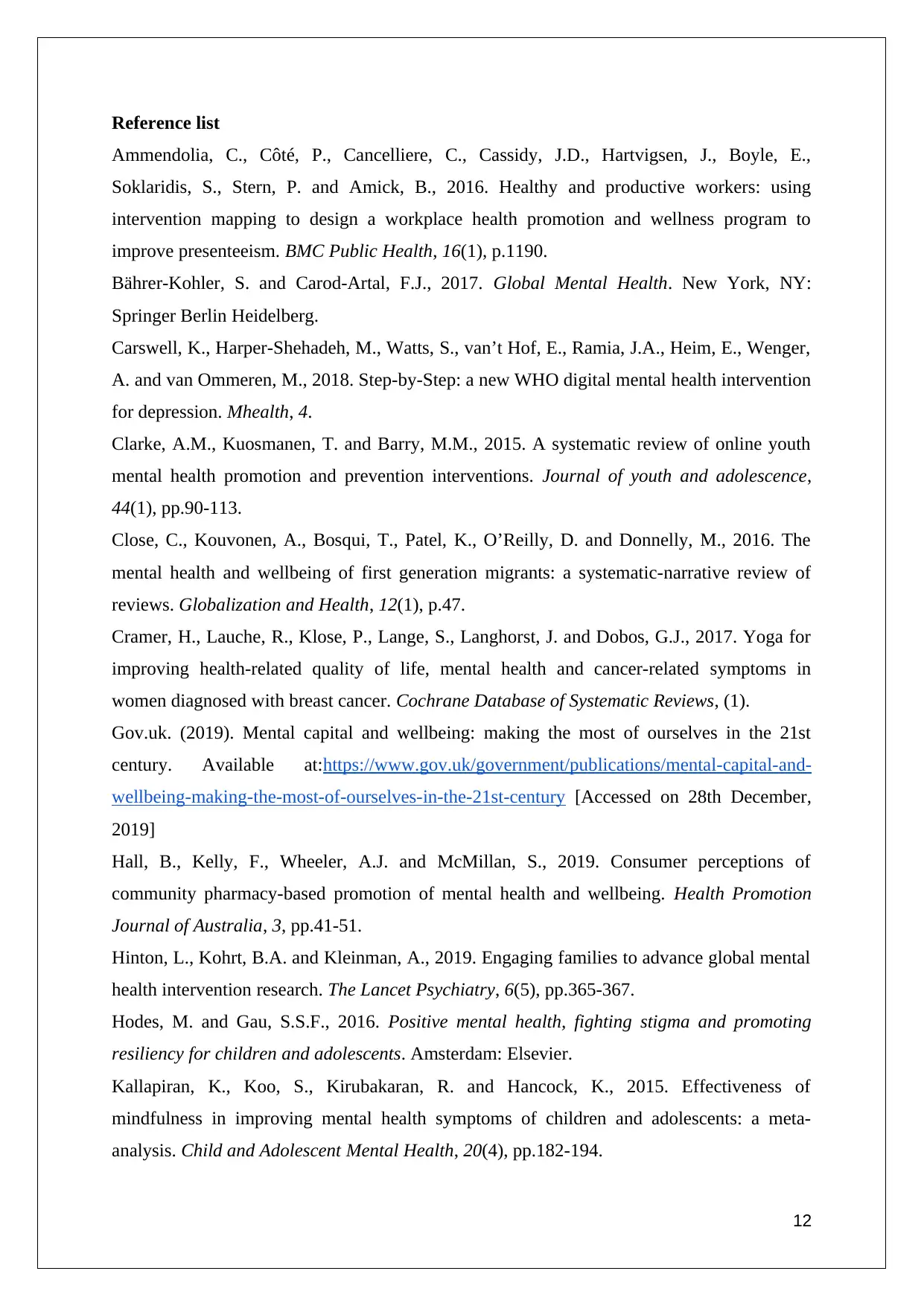
Reference list
Ammendolia, C., Côté, P., Cancelliere, C., Cassidy, J.D., Hartvigsen, J., Boyle, E.,
Soklaridis, S., Stern, P. and Amick, B., 2016. Healthy and productive workers: using
intervention mapping to design a workplace health promotion and wellness program to
improve presenteeism. BMC Public Health, 16(1), p.1190.
Bährer-Kohler, S. and Carod-Artal, F.J., 2017. Global Mental Health. New York, NY:
Springer Berlin Heidelberg.
Carswell, K., Harper-Shehadeh, M., Watts, S., van’t Hof, E., Ramia, J.A., Heim, E., Wenger,
A. and van Ommeren, M., 2018. Step-by-Step: a new WHO digital mental health intervention
for depression. Mhealth, 4.
Clarke, A.M., Kuosmanen, T. and Barry, M.M., 2015. A systematic review of online youth
mental health promotion and prevention interventions. Journal of youth and adolescence,
44(1), pp.90-113.
Close, C., Kouvonen, A., Bosqui, T., Patel, K., O’Reilly, D. and Donnelly, M., 2016. The
mental health and wellbeing of first generation migrants: a systematic-narrative review of
reviews. Globalization and Health, 12(1), p.47.
Cramer, H., Lauche, R., Klose, P., Lange, S., Langhorst, J. and Dobos, G.J., 2017. Yoga for
improving health‐related quality of life, mental health and cancer‐related symptoms in
women diagnosed with breast cancer. Cochrane Database of Systematic Reviews, (1).
Gov.uk. (2019). Mental capital and wellbeing: making the most of ourselves in the 21st
century. Available at:https://www.gov.uk/government/publications/mental-capital-and-
wellbeing-making-the-most-of-ourselves-in-the-21st-century [Accessed on 28th December,
2019]
Hall, B., Kelly, F., Wheeler, A.J. and McMillan, S., 2019. Consumer perceptions of
community pharmacy‐based promotion of mental health and wellbeing. Health Promotion
Journal of Australia, 3, pp.41-51.
Hinton, L., Kohrt, B.A. and Kleinman, A., 2019. Engaging families to advance global mental
health intervention research. The Lancet Psychiatry, 6(5), pp.365-367.
Hodes, M. and Gau, S.S.F., 2016. Positive mental health, fighting stigma and promoting
resiliency for children and adolescents. Amsterdam: Elsevier.
Kallapiran, K., Koo, S., Kirubakaran, R. and Hancock, K., 2015. Effectiveness of
mindfulness in improving mental health symptoms of children and adolescents: a meta‐
analysis. Child and Adolescent Mental Health, 20(4), pp.182-194.
12
Ammendolia, C., Côté, P., Cancelliere, C., Cassidy, J.D., Hartvigsen, J., Boyle, E.,
Soklaridis, S., Stern, P. and Amick, B., 2016. Healthy and productive workers: using
intervention mapping to design a workplace health promotion and wellness program to
improve presenteeism. BMC Public Health, 16(1), p.1190.
Bährer-Kohler, S. and Carod-Artal, F.J., 2017. Global Mental Health. New York, NY:
Springer Berlin Heidelberg.
Carswell, K., Harper-Shehadeh, M., Watts, S., van’t Hof, E., Ramia, J.A., Heim, E., Wenger,
A. and van Ommeren, M., 2018. Step-by-Step: a new WHO digital mental health intervention
for depression. Mhealth, 4.
Clarke, A.M., Kuosmanen, T. and Barry, M.M., 2015. A systematic review of online youth
mental health promotion and prevention interventions. Journal of youth and adolescence,
44(1), pp.90-113.
Close, C., Kouvonen, A., Bosqui, T., Patel, K., O’Reilly, D. and Donnelly, M., 2016. The
mental health and wellbeing of first generation migrants: a systematic-narrative review of
reviews. Globalization and Health, 12(1), p.47.
Cramer, H., Lauche, R., Klose, P., Lange, S., Langhorst, J. and Dobos, G.J., 2017. Yoga for
improving health‐related quality of life, mental health and cancer‐related symptoms in
women diagnosed with breast cancer. Cochrane Database of Systematic Reviews, (1).
Gov.uk. (2019). Mental capital and wellbeing: making the most of ourselves in the 21st
century. Available at:https://www.gov.uk/government/publications/mental-capital-and-
wellbeing-making-the-most-of-ourselves-in-the-21st-century [Accessed on 28th December,
2019]
Hall, B., Kelly, F., Wheeler, A.J. and McMillan, S., 2019. Consumer perceptions of
community pharmacy‐based promotion of mental health and wellbeing. Health Promotion
Journal of Australia, 3, pp.41-51.
Hinton, L., Kohrt, B.A. and Kleinman, A., 2019. Engaging families to advance global mental
health intervention research. The Lancet Psychiatry, 6(5), pp.365-367.
Hodes, M. and Gau, S.S.F., 2016. Positive mental health, fighting stigma and promoting
resiliency for children and adolescents. Amsterdam: Elsevier.
Kallapiran, K., Koo, S., Kirubakaran, R. and Hancock, K., 2015. Effectiveness of
mindfulness in improving mental health symptoms of children and adolescents: a meta‐
analysis. Child and Adolescent Mental Health, 20(4), pp.182-194.
12
⊘ This is a preview!⊘
Do you want full access?
Subscribe today to unlock all pages.

Trusted by 1+ million students worldwide
1 out of 14
Related Documents
Your All-in-One AI-Powered Toolkit for Academic Success.
+13062052269
info@desklib.com
Available 24*7 on WhatsApp / Email
![[object Object]](/_next/static/media/star-bottom.7253800d.svg)
Unlock your academic potential
Copyright © 2020–2025 A2Z Services. All Rights Reserved. Developed and managed by ZUCOL.




![Coursework: Mental Health and Wellbeing of Older People - [University]](/_next/image/?url=https%3A%2F%2Fdesklib.com%2Fmedia%2Fimages%2Fyr%2F3c92269340094292bd18c0d2d99c9706.jpg&w=256&q=75)
